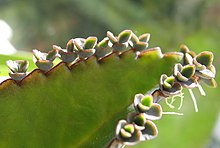Kalanchoe
Kalanchoe is a genus with around 125 species of the Crassulaceae family, native to Europe, although a few have been introduced to America and grow in the wild..
Description
Most are shrubby or herbaceous perennials, with a few annuals or biennials. The largest Kalanchoe beharensis, from Madagascar, can reach 6 m in height, however most do not exceed 1 m. The shapes of the leaves vary according to the species, generally fleshy with a waxy cover, medium to dark green in color; in some species pubescent; with closed margins, crenate or dentate, rarely entire.
The inflorescence is terminal, rarely axillary, and depending on the species, in a corymb, cyme, or panicle. The flowers of this genus are divided into four sections with eight stamens. The petals are fused into a tube, similar to some other related genera, such as Cotyledon.
Flowers from early winter to spring.
Taxonomy
The genera Bryophyllum, described by Salisb. in 1806, and Kitchingia created by Baker in 1881, are considered synonyms of Kalanchoe, although some scientists disagree and treat Bryophyllum as a separate genus..
- Etymology
Kalanchoe: generic name that is supposed to have been named after one of its species (possibly Kalanchoe spathulata) and its Chinese name 伽蓝菜 / 伽蓝菜 jiāláncài, Cantonese ga Salaam-choi. A second explanation derives from the name of the old Indian words: kalanka 'stains, rust' and chaya 'of'.
Some species
|
|
Cultivation and uses
They are often used as houseplants or rockeries and have become popular due to their easy propagation, low water needs, and wide variety of flower colors. The section Bryophyllum -formerly classified as an independent genus- contains species such as Kalanchoe pinnata. In these plants, the new specimens develop vegetatively as seedlings in small natural incisions along the edge of the leaves, which, when detached from the mother, take root.
Like other succulents, species in this genus require little care. They need a lot of light, they even tolerate direct sun, although excessive insolation can burn the leaves. Watering, more frequent during the hot season, must avoid waterlogging of the soil. Most species do not tolerate temperatures below 5 °C.
They appreciate fertilizing during the vegetative period to prolong flowering.
It prefers loose, well-drained soils.
Multiply by stem or leaf cuttings. Some species such as K. daigremontiana you can plant the seedlings that are born on the edges of the leaves.
Diseases
They can suffer from bacterial diseases (such as galls), fungal diseases (such as botrytis), as well as viral and viroid diseases.
Properties
In traditional medicine, Kalanchoe species have been used to treat rheumatism and inflammations through the external route.[citation needed]
Contenido relacionado
Nerve
Vegetable
Deoxyribose
